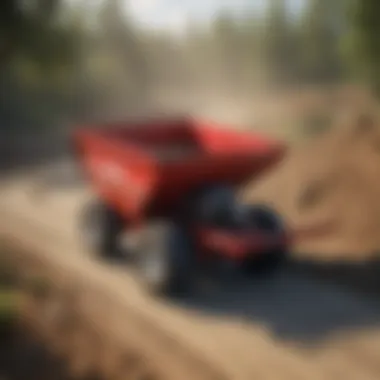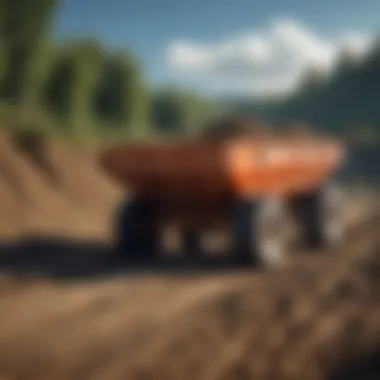The Impact of Power Care Dump Carts on Agriculture


Intro
In contemporary agriculture, there’s an increasing need for machines that simplify labor while enhancing productivity. Power care dump carts have emerged as vital tools that farmers rely on for a range of tasks. These carts are not just another piece of equipment but represent a blend of innovation and practicality. By understanding their various functionalities, farmers can make informed decisions that align with their operational goals.
Topic Overview
Definition and Importance
Power care dump carts are specialized vehicles designed to assist with the transportation of materials throughout a farm. This could range from moving soil, fertilizer, to harvested crops. The importance of these carts can’t be understated. They boost efficiency, reduce human labor, and contribute to overall sustainability in farming operations. With their capacity to handle heavy loads, they help streamline logistics, allowing farmers to focus on other pressing tasks.
Brief History and Evolution
The design and functionality of dump carts have evolved significantly over the years. Initially, simplistic manual carts were utilized, often leading to physical strain and inefficiencies. However, the advent of powered models has revolutionized their use. Modern technological advancements have allowed for features such as hydraulic lifts and enhanced maneuverability, making these carts indispensable in today’s agricultural practices.
Key Techniques and Innovations
Sustainable Farming Practices
The integration of power care dump carts into sustainable farming practices marks a notable evolution in agricultural methodologies. Here’s how they contribute:
- Soil Health: Preserving soil structure by limiting compaction when transporting materials.
- Waste Reduction: Efficiently moving compost and organic waste back to fields, minimizing waste.
- Resource Optimization: Reducing the need for multiple trips, thereby saving fuel and energy.
Advanced Agronomic Technologies
Power care dump carts are now incorporating technological advancements that enhance their functionality. Techniques include:
- Smart Sensors: These can monitor load weights, ensuring that carts are not overloaded.
- GPS Systems: For precise navigation and mapping of fields, contributing to better planning.
- Automated Controls: Streamlining operation by reducing the need for operator intervention, thus focusing resources on other tasks.
Practical Applications
Step-by-Step Guides
Understanding how to properly utilize power care dump carts is essential for maximizing their benefits. Here’s a straightforward guide:
- Preparation: Inspect the cart for any maintenance needs before use.
- Load Management: Ensure loads are balanced and within recommended limits.
- Operational Use:
- Post-Use Care: Clean the cart and check for any signs of wear or damage.
- For unloading, position the cart at designated areas—safety first!
- Engage hydraulic lift (if applicable) to offload materials smoothly.
Case Studies or Real-World Examples
Farmers around the globe are already reaping the benefits of power care dump carts. For example, a group of organic farmers in California adopted these carts for moving compost from their processing site to the fields. They found that not only did it save time, but the reduced number of manual handling steps improved the quality of the compost application.
"Using these dump carts transformed our workflow to a point where we can now spend more hours on crop management rather than logistics," remarked one farmer from the group.
In another instance, a large-scale operation in the Midwest integrated power care dump carts into their harvest process, allowing for quicker transport of crops from the field to storage. This led to a notable reduction in spoilage and losses compared to previous years.
By diving into the functionalities, innovations, and real-world applications of power care dump carts, it becomes clear why they hold such significance in modern agriculture. As the industry continues to progress, these tools will likely become even more essential to farming success.
Prelims to Power Care Dump Carts
In the vast landscape of modern agriculture, efficiency and adaptability stand out as hallmark traits for successful farming operations. Power care dump carts play a pivotal role in this setting, evolving from simple tools for transportation to essential components that enhance productivity. Understanding these carts is not merely about recognizing their physical form; it's about appreciating how they integrate into the broader framework of agricultural practices.
These machines serve varied purposes, from aiding in the collection and transport of produce to managing waste effectively. Farms today juggle a multitude of tasks, and the right equipment can spell the difference between a successful season and a lackluster harvest.
Moreover, power care dump carts are designed with versatility in mind. Whether it's carrying heavy loads of soil, fertilizer, or harvested crops, their structural composition and hydraulic systems allow them to handle the rigors of agricultural work efficiently.
Broad Applications and Adaptability


One of the most compelling aspects of these dump carts is their adaptability across different farming sectors. This includes:
- Crop transport: Delivering harvested grains or vegetables to storage facilities.
- Soil management: Moving soil amendments to specific fields quickly.
- Waste removal: Assisting in the disposal of organic waste, which is crucial for maintaining soil health.
Understanding how these carts function is foundational for anyone involved in agriculture, from seasoned farmers to novitiates. Their utility can significantly impact farm management and operational sustainability.
"The difference between a dream and a goal is a timeline — having the right tools, like power care dump carts, helps turn agricultural ambitions into reality."
As we delve deeper into the mechanics, design features, and applications of power care dump carts, it becomes clear that these carts are not just an add-on to farming equipment but integral to cultivating a successful and sustainable agricultural future.
The Mechanics of Dump Carts
Understanding the mechanics behind dump carts is essential to grasping their role in modern agriculture. These carts are not merely containers on wheels; they function as vital tools that facilitate various tasks on farms, ranging from transporting soil to disposing of waste. Knowing how they operate can lead to better investment and usage decisions for farmers.
How Dump Carts Function
Dump carts rely on a simple yet effective mechanism to perform their tasks. The main components include the cart body, axle, wheels, and the dumping mechanism, typically activated by a manual or hydraulic lever. When farmers load a dump cart, weight is evenly distributed to enhance stability and maneuverability. As a result, when it's time to unload, the cart can tip at an angle, allowing for efficient material removal.
Consider the scenario where a farmer uses a dump cart to relocate compost. By positioning the cart near the compost pile, the farmer can simply load the materials in, and when reaching the designated area, a gentle pull of the lever tilts the cart, spilling the compost in an optimal location. This efficiency can save time and energy, proving crucial in a bustling farming environment.
In addition, many dump carts are designed to function in various terrains, whether it be rugged dirt paths or smooth farm roads. This versatility means that farmers can use them for different activities without needing specialized equipment for each task. Understanding the mechanics allows for better utilization, ensuring that every dollar spent goes towards maximizing productivity on the farm.
Types of Power Sources
The power source for dump carts can greatly influence their functionality and suitability for specific tasks. Here are the primary types:
- Manual Operation: Many traditional dump carts are powered by hand. Farmers must pull or push the cart, and the tilt mechanism usually involves a lever that one can operate manually. This form requires no additional investment or technology and is perfect for smaller farms or personal gardens.
- Tractor-Powered: Larger dump carts often attach to tractors. This setup allows for heavy loads, making it suitable for large-scale farming operations. The tractor's power provides strong performance over longer distances and varied terrains.
- Electric-Powered: With the move towards sustainability, some dump carts are equipped with electric motors. These models are quiet and can operate without emissions, which is beneficial for both the environment and the farmer's health.
Each power source comes with its own set of benefits and considerations. For instance, while manual carts are economical, they might not suit farms with vast acres or heavy materials. On the other hand, electric power sources might reduce physical labor but require reliable charging solutions.
Overall, the mechanics of dump carts is vital knowledge for farmers looking to enhance operational efficiency, understanding which type fits their needs can make all the difference in the long run.
Design Features of Power Care Dump Carts
In the context of contemporary agriculture, the design features of power care dump carts are not just functional elements—they serve as crucial contributors to operational efficiency. These carts are the unsung heroes of the farming world, enabling farmers to transport a variety of materials with ease. Understanding the specific elements that comprise their design can reveal much about how these tools improve productivity and user experience.
Material Composition
The choice of materials in the construction of power care dump carts is paramount. Carts are often made from high-strength steel or aluminum, each providing distinct advantages. High-strength steel offers durability and longevity, suitable for heavy loads and rough terrains. On the other hand, aluminum is lightweight, which helps improve fuel efficiency when towed. Some manufacturers are even experimenting with advanced composites, which can be strong and lightweight, providing farmers with options tailored to their unique requirements.
Additionally, it’s important to consider the cart bed material, as it impacts both capacity and maintenance. For instance, a rubberized bed can reduce material spillage, while a plastic or coated surface can resist corrosion better, extending the cart's lifespan.
Volume Capacity and Dimensions
Volume capacity and dimensions of the dump carts are designed keeping in mind the varied needs of modern farms. Ranging from small 2-cubic-yard machines suitable for home gardens to larger 10-cubic-yard versions for expansive operations, farmers can select carts based on the scale of their tasks.
The height and width of the cart also play a role in loading efficiency. For example, a low-profile dump cart can make it easier to load heavy materials without the need for extensive lifting. Furthermore, optimizing the cart’s dimensions allows it to navigate through narrow pathways, which is often essential in both horticulture and landscaping applications.
Key considerations regarding volume include:
- Weight Distribution: An evenly distributed load helps in maintaining stability when towed.
- Dumping Mechanism Height: A higher dump height can ensure that materials are deposited directly into a collection bin or truck, minimizing cleanup time.
Ergonomics and User Experience
Ergonomics is another critical design feature that influences the use of power care dump carts. A well-designed dump cart should make the user’s task easier and reduce strain. Elements such as adjustable hitch heights allow for better alignment with the towing vehicle, which enhances handling. Furthermore, easy-to-access controls for the dumping mechanism provide convenience, enabling efficient operations without requiring excessive physical effort.
Comfort plays a vital role too. Operators who spend long hours managing these carts benefit from features like padded handles and cushioned seats on the towing vehicle, reducing fatigue.
Moreover, the visual design ensures that users can easily see the load while in motion, which improves safety. Carts with reflective surfaces or bright colors can enhance visibility, especially in low-light conditions, effectively minimizing potential accidents.


"A perfect blend of functionality and user-centric design allows modern dump carts to meet the increasing demands of the agricultural sector."
Applications in Agriculture
Power care dump carts serve as essential tools in various agricultural settings, enhancing productivity while easing the workload for farmers. Their designs and functionality cater to a range of activities on the farm, contributing to efficiency in both large-scale and smaller operations. This section explores the diverse applications of dump carts, highlighting their utility across general farming, horticulture, landscaping, and waste management.
"With a well-structured approach to agriculture, power care dump carts can transform your farming experience."
General Farm Use
The versatility of power care dump carts makes them indispensable for general farm activities. These carts easily transport materials such as soil, fertilizer, and harvested crops, streamlining day-to-day operations. Farmers often note that having a reliable dump cart at their disposal is akin to having an extra set of hands.
For instance, consider a scenario where a farmer needs to move manure from livestock areas to the compost site. Using a dump cart, this task becomes more manageable and less time-consuming. Here are some key advantages of general farm use of these carts:
- Enhanced Workflow: The application of dump carts likely reduces the number of trips between the barn and fields, optimizing overall productivity.
- Durability & Stability: Most models are designed to handle heavy loads without compromising balance.
- Multi-Functionality: These carts can also be used for seeding, hauling equipment, and transporting tools.
Horticulture and Landscaping
In horticulture and landscaping, the use of power care dump carts has grown remarkably. Their ability to carry a variety of materials such as mulch, plants, and gardening supplies supports tasks that are often laborious and time-consuming. Landscape designers particularly appreciate how these carts can navigate through tight spaces without fuss.
The integration into horticulture is evident through several applications:
- Soil Transportation: When planting flowers or shrubs, moving soil in bulk can save both time and physical strain.
- Plant & Supply Delivery: Dump carts facilitate the movement of plants and supplies from storage areas or nurseries directly to work sites.
- Waste Disposal: Trimming and prunning generate a significant amount of waste. Using a dump cart makes removing debris efficient and clutter-free.
Management of Agricultural Waste
Waste management is a crucial but often overlooked aspect of modern agriculture. Power care dump carts provide a practical solution for the efficient management of agricultural waste. Instead of relying on traditional methods that can be laborious and inefficient, farmers can utilize these carts to easily gather and dispose of waste materials.
Effective waste management using dump carts includes:
- Composting: Farmers can transport organic waste, such as plant debris and leftover feed, to designated compost sites.
- Manure Removal: In livestock operations, effective handling of manure is critical for maintaining hygiene and environmental standards.
- Recycling Materials: Farmers can collect recyclable items like plastic or metal and transport them to recycling points, promoting sustainability.
Each application section supports the overarching theme that dump carts are not merely tools, but essential components of efficient agricultural practices. The benefits gained from their use reflect positively on productivity, environmental stewardship, and overall farm management.
Benefits of Using Dump Carts
In modern agriculture, the efficiency and effectiveness of operations can directly affect productivity and profitability. Power care dump carts stand out as vital tools to achieve these goals. The importance of adopting dump carts in farming cannot be overstated. These machines are designed to streamline processes, manage resources effectively, and reduce labor intensity. As the agricultural landscape continues to evolve, understanding the multiple benefits of using dump carts is crucial for farmers and industry enthusiasts.
Enhanced Efficiency
Quite simply, when it comes to moving materials, time is often of the essence. Dump carts play a key role in enhancing efficiency on the farm. They allow farmers to transport goods—be it soil, fertilizers, or even harvested crops—swiftly from one point to another. The design of these carts enables a quick unloading process, reducing the time spent on manual handling.
Consider a scenario where a farmer needs to transport compost from a pile on one end of the farm to the fields on the other. Using a dump cart, this task can be accomplished efficiently, as the cart's mechanism allows for easy unloading. All it takes is a simple lever action that lifts the dumping bed and voilà, the material is released almost effortlessly.
Additionally, the use of dump carts minimizes the need for repetitive trips back and forth, cutting down on fuel consumption. When farmers have access to effective tools that allow them to move large quantities in one go, they're able to allocate their time to strategic tasks that boost productivity further. Ultimately, increased efficiency reflects in improved yields and a stronger bottom line.
Cost-Effectiveness
Next up, let’s talk about cost-effectiveness—an essential consideration for anyone running an agricultural operation. While the initial investment in a high-quality dump cart may seem significant, the long-term savings can astonish even the most skeptical farmer.
For example, by reducing labor costs through less manpower needed for material handling, dump carts allow farm owners to allocate resources in a more effective manner. Less time spent on transporting materials means more time available for other critical farming tasks that require attention.
Moreover, when using dump carts, wear and tear on other equipment can also decrease. If one is moving materials using larger, more cumbersome machinery unnecessarily, it can lead to higher maintenance costs over time. Dump carts, specifically designed for agility and efficiency, often do not require the same level of upkeep as larger machinery.
In essence, while the upfront cost can raise an eyebrow, the overall effect on budget can be significant, suggesting that investing in a dump cart is an expense that pays for itself.
Environmental Considerations


Lastly, addressing the environmental considerations surrounding the use of dump carts is becoming increasingly important for farmers today. Sustainability is not just a buzzword; it’s a necessity. Utilizing dump carts promotes better environmental stewardship in several ways.
"Changing how we think about agriculture also means changing how we transport and utilize resources on the farm."
By using dump carts to transport materials, farmers can minimize their carbon footprints. This mechanism can support practices that prioritize soil conservation and responsible waste management. For instance, by efficiently transporting organic waste to composting sites or soil amendments back to fields, dump carts facilitate sustainable practices without burdening the environment.
Less reliance on fuel-guzzling transport options means that dump carts align well with modern goals of reducing greenhouse gas emissions. Additionally, many manufacturers are beginning to incorporate sustainable materials into the construction of their carts, further addressing concerns about resource usage in production.
Maintenance of Power Care Dump Carts
Maintaining Power Care dump carts is not just about keeping up appearances; it’s crucial for ensuring they operate efficiently and last longer. Neglecting maintenance can lead to breakdowns and costly repairs that can hinder a farm's productivity. Moreover, dump carts are key assets in agriculture, and their upkeep can significantly influence the overall efficiency of farming operations. Regular maintenance practices help identify potential issues before they escalate, keeping the equipment running smoothly.
Regular Maintenance Practices
For keeping dump carts in top shape, a few regular practices can’t be overlooked:
- Cleaning After Use: After each use, it’s handy to give your dump cart a thorough wash down. Removing mud and debris prevents rust and damage to moving parts.
- Inspecting the Tires: Always check tire pressure and tread. Low pressure not only increases rolling resistance but can impact overall maneuverability.
- Lubrication: Regularly lubricating hinges, axles, and other moving parts goes a long way in preventing wear and tear. A little grease can avoid major headaches down the road.
- Checking for Loose Bolts: Equipment can shake a bit during operation, leading to loose bolts or fasteners. A quick check ensures everything stays secure.
- Battery Maintenance: If your dump cart has an electric power source, checking battery connections and clean terminals is vital. A small corrosion issue can affect performance significantly.
By adhering to these practices, farmers can extend the life of their dump carts, reduce the likelihood of unexpected failures, and enhance the overall efficiency of their agricultural efforts.
Troubleshooting Common Issues
Despite regular maintenance, issues might still arise. Here are some common problems and their fixes:
- Stuck Hydraulic System: If the lift mechanism isn’t responding, check the fluid levels. Insufficient hydraulic fluid can cause it to jam. Refill as necessary.
- Uneven Load Distribution: This can lead to tipping or mishandling during transport. When loading, ensure the weight is evenly distributed to prevent instability.
- Difficult Maneuvering: If steering feels off, inspect the wheels for alignment. Misalignment can hinder performance and lead to excessive wear.
- Rust or Corrosion: Notice any rust spots? Sanding them down and applying a protective coating can prevent further damage.
Remember: Addressing these issues promptly can save time and money.
Adequate maintenance and timely troubleshooting are vital for the lifespan and functionality of Power Care dump carts. Awareness of common issues, combined with a proactive maintenance approach, empowers farmers to maximize their investment.
Future Innovations in Dump Cart Technology
The agricultural landscape continues to evolve, and one of the pivotal areas of progress is the innovation of dump cart technology. As farmers face increasing demands for efficiency and sustainability, the push for advanced solutions in equipment is more crucial than ever. Future innovations in dump cart technology are set to not only optimize farm operations but also significantly reduce the resource footprint of agriculture.
Smart Technology Integration
Smart technology is redefining expectations across various industries, and agriculture is no exception. The integration of smart technology into power care dump carts is on the rise, leading to enhanced operational efficiency and tracking capabilities.
- GPS Tracking: By embedding GPS systems into dump carts, farmers can monitor the precise location of their equipment. This is crucial for large farms where equipment may not be easily visible. Knowing where everything is can save time and reduce the risk of theft.
- Data Analysis: Integrating analytics allows farmers to collect data on usage patterns, load weights, and travel routes. Such insights enable informed decision-making on both equipment utilization and maintenance schedules. For example, understanding load capacity trends helps in optimizing the cart for various tasks without overloading.
- Remote Diagnostics: Advanced sensors can alert users to potential issues before they develop into serious problems. Imagine being notified on your smartphone that the wheel bearings need attention. This proactive approach not only saves money on potential repairs but also avoids downtime during critical planting or harvest seasons.
Smart technology adds a layer of convenience and productivity that can significantly alter how dump carts function in everyday farming operations. As the technology continues to develop, one can expect even more innovations tailored to the specific needs of different agricultural sectors.
Sustainable Materials and Production Techniques
Sustainability is at the forefront of modern agriculture, and the materials used in manufacturing power care dump carts are increasingly coming under scrutiny. The choice of materials and production methods has a direct impact on ecological footprints and resource conservation.
- Recyclable Materials: Developers are gradually shifting to materials that are not only strong but also recyclable. For instance, plastics derived from renewable resources or metals that can be recycled. These materials reduce waste and conserve natural resources.
- Lightweight Yet Strong: Innovations in composite materials allow manufacturers to produce lighter dump carts that retain high strength. This modification lowers fuel consumption, translating to economic savings and reduced greenhouse gas emissions during transport.
- Method of Production: Techniques like additive manufacturing (3D printing) allow for precision crafting of dump cart components. This significantly minimizes material waste compared to traditional manufacturing processes while also decreasing the overall energy required for production.
The shift towards using sustainable materials and production techniques showcases an awareness that agriculture needs to balance productivity with ecological responsibility. By adapting these changes, farm equipment can empower farmers not only to work efficiently but also to contribute positively to environmental stewardship.
"A sustainable approach to agriculture is not merely an option; it is an obligation we owe to future generations."
End
In wrapping up our examination of power care dump carts, it's clear that these tools are not merely accessories for modern farms; they are essential components woven into the fabric of agricultural efficiency and sustainability. The significance of understanding their functionality cannot be overstated. By grasping how these carts operate, farmers can dramatically improve their workflow, saving time and labor.
One of the key benefits lies in the versatility of dump carts. They are applicable in various scenarios—from transporting soil and seeds to managing waste effectively. Their design, which embraces both practicality and comfort, is crucial for improving user experience. Ergonomic features reduce fatigue, allowing farmers to work longer and more efficiently.
As we've explored, the integration of smart technology is shaping the future of these carts. Farmers adopting smart syncing features can track load capacities, monitor wear and tear, and even optimize routes within their fields. This level of data can drive immediate improvements and long-term sustainability in farming operations.
Furthermore, the emphasis on sustainable materials during production reinforces a commitment not just to enhanced performance but to environmental stewardship, resonating with the growing demand for eco-friendly practices in agriculture.
"Adopting advanced technology in agriculture, like power care dump carts, aligns with the broader goals of modern farming—efficiency, sustainability, and innovation."
Looking forward, the evolution of dump carts will likely accompany ongoing advancements in agricultural technology. This ability to adapt will be pivotal for farmers aiming to stay competitive and environmentally conscious. Thus, understanding power care dump carts is not just about recognizing their current capabilities; it's about anticipating future trends and preparing to capitalize on them. Farmers and enthusiasts alike should remain informed about developments that can enhance productivity and sustainability in their operations.



